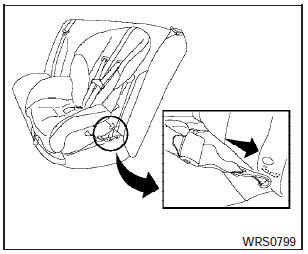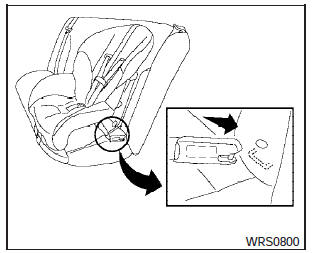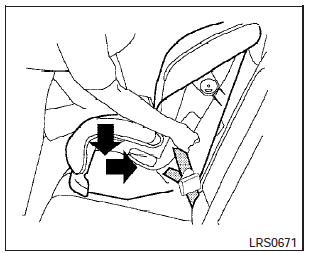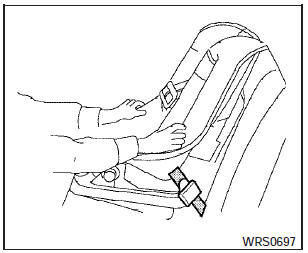 Nissan Maxima: Forward-facing child restraint installation using latch
Nissan Maxima: Forward-facing child restraint installation using latch
Refer to all Warnings and Cautions in the Child Safety and Child Restraint sections before installing a child restraint.
Follow these steps to install a forward-facing child restraint using the Latch system:
1. Position the child restraint on the seat. Always follow the child restraint manufacturer s instructions.

Forward-facing
web-mounted step 2
2. Secure the child restraint anchor attachments to the Latch lower anchors. Check to make sure the Latch attachment is properly attached to the lower anchors.
If the child restraint is equipped with a top tether strap, route the top tether strap and secure the tether strap to the tether anchor point. See Installing top tether strap in this section. Do not install child restraints that require the use of a top tether strap in seating positions that do not have a top tether anchor.

Forward-facing
rigid-mounted step 2
3. The back of the child restraint should be secured against the vehicle seatback.
If necessary, adjust or remove the headrest to obtain the correct child restraint fit. If the headrest is removed, store it in a secure place. Be sure to reinstall the headrest when the child restraint is removed.
See Adjustable headrest in this section for headrest adjustment information.
If the seating position does not have an adjustable headrest and it is interfering with the proper child restraint fit, try another seating position or a different child restraint.

Forward-facing
step 4
4. For child restraints that are equipped with webbing-mounted attachments, remove any additional slack from the anchor attachments.
Press downward and rearward firmly in the center of the child restraint with your knee to compress the vehicle seat cushion and seatback while tightening the webbing of the anchor attachments.

Forward-facing
step 5
5. After attaching the child restraint, test it before you place the child in it. Push it from side to side while holding the child restraint near the Latch attachment path. The child restraint should not move more than 1 inch (25 mm), from side to side. Try to tug it forward and check to see if the Latch attachment holds the restraint in place. If the restraint is not secure, tighten the Latch attachment as necessary, or put the restraint in another seat and test it again. You may need to try a different child restraint. Not all child restraints fit in all types of vehicles.
6. Tighten the tether strap according to the manufacturers instructions to remove any slack.
7. Check to make sure the child restraint is properly secured prior to each use. If the child restraint is loose, repeat steps 3 through 5.
 Rear-facing child restraint installation using the seat belts
Rear-facing child restraint installation using the seat belts
Rear-facing child
restraint installation using the seat belts
WARNING:
The three-point seat belt with Automatic Locking Retractor (ALR) must be used
when installing a child restraint. Fa ...
 Forward-facing child restraint installation using the seat belts
Forward-facing child restraint installation using the seat belts
WARNING:
The three-point seat belt with Automatic Locking Retractor (ALR) must be used
when installing a child restraint. Failure to use the ALR mode will result in the
child restraint not being ...
See also:
Rear Seat Belts
The shoulder belt anchorages of the rear three-point belts
are nonadjustable for outboard and center rear passengers
on sedans. The center belt is mounted to the rear
shelf panel and exits throu ...
Hydraulic Power Steering
If your vehicle has hydraulic power
steering, it may require
maintenance. See Power Steering
Fluid (2.4L L4 Engine) or Power Steering Fluid
(3.6L V6 Engine).
If power steering assist is lost ...
Checking and adding oil
Location of the filler cap and dipstick
Volvo recommends Castrol oil products
NOTE
Before checking the oil:
The car should be parked on a level surface.
If the engine is warm, wait f ...
